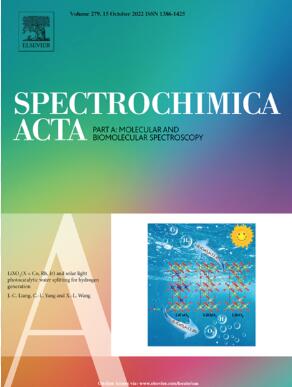高SERS活性银纳米球修饰银纳米星/ZIF-8复合材料测定双奎特和硫胺残基
IF 4.6
2区 化学
Q1 SPECTROSCOPY
Spectrochimica Acta Part A: Molecular and Biomolecular Spectroscopy
Pub Date : 2025-08-09
DOI:10.1016/j.saa.2025.126813
引用次数: 0
摘要
在表面增强拉曼散射(SERS)测量中,“热点”的产生和分析物在这些区域的有效浓度对于提高检测灵敏度至关重要。在这项工作中,首先用金属有机骨架ZIF-8包覆Ag纳米星/ZIF-8复合材料(Ag NS/ZIF-8/Ag),然后静电自组装Ag纳米球,获得了一种具有高SERS活性的新型复合材料。由于丰富的等离子体纳米间隙,包括银纳米星和银纳米球之间的间隙,以及相邻银纳米球之间的间隙,复合材料产生了许多热点,从而获得了出色的SERS性能。该方法成功地应用于果汁中二甘菊和硫丹的定量和同时检测,检出限分别为5.0 × 10−8 mol/L和1 × 10−8 mol/L,回收率为86.6% ~ 118.4%。值得注意的是,在紫外线照射下,该复合材料能够在80分钟内有效地降解农药。此外,在连续5个检测周期内,其可重复使用性被证明具有很强的SERS活性。这些结果强调了Ag - NS/ZIF-8/Ag复合材料对农药SERS敏感检测的能力。本文章由计算机程序翻译,如有差异,请以英文原文为准。

Highly SERS active composite of silver nanospheres-decorated Ag nanostar/ZIF-8 for determination of diquat and thiram residues
In surface-enhanced Raman scattering (SERS) measurements, the creation of “hot spots” and the effective concentration of analytes in these areas are crucial for enhancing detection sensitivity. In this work, a novel composite with highly SERS activity, Ag nanospheres decorated Ag nanostar/ZIF-8 composite (Ag NS/ZIF-8/Ag) was achieved via first coating the Ag nanostars with the metal-organic framework ZIF-8, known for its strong molecular adsorption capabilities, followed by the electrostatic self-assembly of Ag nanospheres. The composites produce numerous hotspots due to the abundant plasmonic nanogaps, including the interstitial space between the Ag nanostar and Ag nanospheres, as well as internanogaps between neighboring Ag nanospheres, resulting in outstanding SERS performance. It was successfully applied for the quantitative and simultaneous detection of diquat and thiram in fruit juice, achieving detection limits of 5.0 × 10−8 mol/L and 1 × 10−8 mol/L, respectively, with recovery rates ranging from 86.6 % to 118.4 %. Notably, under UV light exposure, the composite was able to degrade pesticides efficiently within 80 min. Additionally, its reusability was demonstrated by sustaining strong SERS activity over five continuous detection cycles. These results emphasize the capability of Ag NS/ZIF-8/Ag composites for sensitive pesticide detection via SERS.
求助全文
通过发布文献求助,成功后即可免费获取论文全文。
去求助
来源期刊
CiteScore
8.40
自引率
11.40%
发文量
1364
审稿时长
40 days
期刊介绍:
Spectrochimica Acta, Part A: Molecular and Biomolecular Spectroscopy (SAA) is an interdisciplinary journal which spans from basic to applied aspects of optical spectroscopy in chemistry, medicine, biology, and materials science.
The journal publishes original scientific papers that feature high-quality spectroscopic data and analysis. From the broad range of optical spectroscopies, the emphasis is on electronic, vibrational or rotational spectra of molecules, rather than on spectroscopy based on magnetic moments.
Criteria for publication in SAA are novelty, uniqueness, and outstanding quality. Routine applications of spectroscopic techniques and computational methods are not appropriate.
Topics of particular interest of Spectrochimica Acta Part A include, but are not limited to:
Spectroscopy and dynamics of bioanalytical, biomedical, environmental, and atmospheric sciences,
Novel experimental techniques or instrumentation for molecular spectroscopy,
Novel theoretical and computational methods,
Novel applications in photochemistry and photobiology,
Novel interpretational approaches as well as advances in data analysis based on electronic or vibrational spectroscopy.

 求助内容:
求助内容: 应助结果提醒方式:
应助结果提醒方式:


